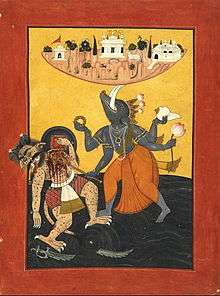Hiranyaksha
Hiranyaksha (Sanskrit: हिरण्याक्ष, "golden-eyed"), also known as Hiranyanetra (Sanskrit: हिरण्यनेत्र)[1] was an oppressive demon Asura who attacked the heavens and thereafter kidnapped and attempted to destroy the earth goddess in Hindu mythology.[2][3]
| Hiranyaksha | |
|---|---|
The boar avatar Varaha, the third incarnation of Vishnu, stands in front of the decapitated body of the demon Hiranyaksha | |
| In-universe information | |
| Affiliation | demon king (only for some time) |
| Weapon | Mace |
Vishnu's guardians Jaya-Vijaya, were cursed by 4 kumara sages (Bramha's sons) to incarnate on Earth either 3 times as enemies of Lord Vishnu OR 7 times as devotees of Lord Vishnu. They chose to take birth on earth 3 times. In the first birth (During Satya Yuga), they were born as Hiranyakashipu and Hiranyaksha. In the second birth (During Treta Yuga), they were born as Ravana and Kumbhakarna. In the third birth (During Dwapara Yuga), they were born as Shishupala and Dantavakra. The references are from stories of Bhagavata Purana.
Some of the Puranas present him as the son of Diti and Kashyap.[2] Kashyapa (Sanskrit: कश्यप kaśyapa) was an ancient sage (rishis), who is one of the Saptarshis in the present Manvantara; with others being Atri, Vashishtha, Vishvamitra, Gautama, Jamadagni, and Bharadwaja. He was the father of the Devas, Asuras, Nagas and all of humanity. He married Aditi, with whom he fathered Agni, the Aditya. With his second wife, Diti, he begot the Daityas. In this Puranic version, the good Suras and evil Asuras are the children of the same Kashyapa, and there is a constant war between good and evil.
Once, Hiranyaksha assaulted the defenseless Mother Earth and pulled her deep into the cosmic ocean. The demi-gods appealed to Vishnu to save the earth goddess and all life. Vishnu took the avatar of a man-boar (Varaha) and went to rescue the goddess. Hiranyaksha blocked him. He was then slain by Vishnu.[2][3]
Origins and significance
The Hindu legend has roots in the Vedic literature such as Taittariya Samhita and Shatapatha Brahmana, and is found in many post-Vedic texts.[4][5] These legends depict goddess earth (Bhudevi, Prithivi) in an existential crisis where neither she nor the life she supports can survive. She is drowning and overwhelmed in the cosmic ocean. Vishnu emerges in the form of a man-boar avatar. He, as the hero in the legend, descends into the ocean and finds her, she hangs onto his tusk, and he lifts her out to safety. The good wins, the crisis ends, and Vishnu once again fulfills his cosmic duty. The Varaha legend has been one of many historic legends in the Hindu text embedded with right versus wrong, good versus evil symbolism, and of someone willing to go to the depths and do what is necessary to rescue the good, the right, keep up the dharma.[4][5][6]
Related legend
Hiranyaksha had an elder Brother named Hiranyakashipu, who tried to persecute his son Prahlada for his faith in Lord Vishnu. While Hiranyaksha was slain by Varaha, the boar avatar of Lord Vishnu, the elder brother Hiranyakashipu was killed by Narasimha, the man-lion avatar of Vishnu.[2]
In some texts, Hiranyaksha is an incarnation of one of the dwarapalas (gatekeepers) of Vishnu named Vijaya. He, along with his brother Jaya (born as Hiranyakashipu, elder brother of Hiranyaksha) were cursed to be born as evil asuras three times, since they had angered the four kumaras (devotees of Lord Vishnu) by not letting them see Lord Vishnu.
Gallery
 Alternate representation of Hiranyaksha and Varaha, 17th-century Mughal style painting
Alternate representation of Hiranyaksha and Varaha, 17th-century Mughal style painting Pahari style painting showing Hiranyaksha and Varaha in ocean with rescued earth on top
Pahari style painting showing Hiranyaksha and Varaha in ocean with rescued earth on top_purpose_is_to_recover_the_Vedas_from_the_bottom_of_the_ocean.jpg) Varaha Avatar's (incarnation's) purpose is to recover the Vedas from the bottom of the ocean
Varaha Avatar's (incarnation's) purpose is to recover the Vedas from the bottom of the ocean
See also
References
- George M. Williams (27 March 2008). Handbook of Hindu Mythology. Oxford University Press. pp. 54–. ISBN 978-0-19-533261-2. Retrieved 28 August 2013.
- Roshen Dalal (2010). Hinduism: An Alphabetical Guide. Penguin Books. p. 159. ISBN 978-0-14-341421-6.
- George M. Williams (2008). Handbook of Hindu Mythology. Oxford University Press. pp. 154–155, 223–224. ISBN 978-0-19-533261-2.
- H. von Stietencron (1986). Th. P. van Baaren; A Schimmel; et al. (eds.). Approaches to Iconology. Brill Academic. pp. 16–22 with footnotes. ISBN 90-04-07772-3.
- Debala Mitra, ’Varāha Cave at Udayagiri – An Iconographic Study’, Journal of the Asiatic Society 5 (1963): 99-103; J. C. Harle, Gupta Sculpture (Oxford, 1974): figures 8-17.
- Joanna Gottfried Williams (1982). The Art of Gupta India: Empire and Province. Princeton University Press. pp. 42–46. ISBN 978-0-691-10126-2.
- Dictionary of Hindu Lore and Legend (ISBN 0-500-51088-1) by Anna Dhallapiccola
| Preceded by Started |
Daityas - |
Succeeded by Hiranyakashipu |

